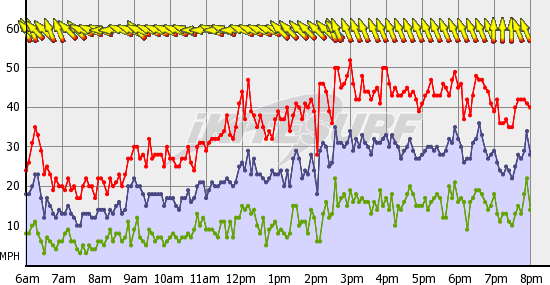
 |
|
#1
|
||||
|
||||
|
Republican, Democrat, retailer, school, friend, foe...keep your agendas to yourself on this one....only put in if you really want to help the sport...
So many (of us) want to go out in gnarly conditions...why? Why was "big wave" redefined recently? Why do divers keep going deeper? Why do we keep raising the bar? How much is too much? and why? What about speed kiting? How about offshore high wind? How about short lines? What gusts are a fun challenge and what is too deadly? Is there another style of kiteboarding being developed?: Extreme Kiteboarding...not for your average kiter... Old School, Freestyle, Wakestyle, Surf, and now: High Wind Kiting
__________________
Ride On. Brad Lange Seven Kiteboarding, Islamorada, Florida Keys www.sevensports.com 305-853-KITE Last edited by b-rad; 08-25-2008 at 12:09 PM. |
|
#2
|
||||
|
||||
|
Quote:
Hey Brad, I would be careful not to confuse terms. There is high, sustained wind and then there are squall winds. You know what to rig and to a degree what to expect in high sustained winds. That is frequently not the case in squalls. Did you see the wind and radar plots from Fay at the link below? http://fksa.org/showthread.php?t=7046&page=4 I hope as a well regarded professional in the industry you are not advocating that guys go out into that stuff? Or, is that what you are saying? You realize that as bad as the wind in those plots looks, squalls throw out worse conditions (higher spikes, lower lulls, violent wind reversals) on a regular basis? Brad, guys die in these conditions, recall the doctor who was killed about a week ago or the man that was killed last year in TS Ernesto. Many more just get hurt, like some students in the nordic countries one of which will likely be paralyzed below the waist for life. There are so many more cases. Skill doesn't count for much in certain weather extremes or if some things go wrong. Add to that we all make mistakes. At the same time, you can't afford to make mistakes in such extreme conditions. Also, gear breaks not uncommonly especially in extreme conditions. Some breaks can cook you but good. NO ONE knows in advance the wind speed and direction changes, lightning a squall will throw out. They can be so extreme as to defy dealing with them. Russian roulette comes to mind as a similar activity. Skill and ability may have little to do with the outcome, just luck. This has been established in my mind for many years but not everyone sees it this way sad to say. I don't view promoting going out in this stuff as responsible. Our sport took a major hit from this last accident. Are you advocating that folks do more of the same or do I have it wrong. p.s. regarding divers going deeper. True, but with a very big difference, in record attempts they use their heads, security provisions BIG time, procedures, etc.. There is no comparison to my 300 ft. drop on a single 72 cft. tank into intense narcosis and O2 toxicity over 30 years ago and what they do today. People still die but the controls and awareness are far greater than before. They don't just "do it", if so, they will likely get "done" themselves.
__________________
FKA, Inc. transcribed by: Rick Iossi |
|
#3
|
|||
|
|||
|
High wind - go!
Cracked out squally wind - NO! I can't wait for east winds of 30-40 in the keys every year. We don't get much of it but when we do, it's on. But! Squally winds of 25 -55 is asking for bans. Some beginners see us do these things and think it's ok not realizing the potential dangers even after you warn them against it. I remember being in Delray with Shannon and a few others lit on 7-9m kites and a local asked me if I thought his friend would be ok as an intermediate rider on an 11m. I said no way. I am lit up on my 9 and if you don't have a 7, forget it. Then I went out riding. @ 10 minutes later I saw him launcing his kite and he pulled a little to hard on the bar and WHAM!!! Can you say 20 ft. loft? He was then slamed to the ground and his kite hit the shack. He said after that he should have listened to the better riders advise. But of course that was hindsight. When the wind is cranking and people are riding, it sets the stage for others to think it is OK even if you tell them otherwise. |
|
#4
|
|||||||||
|
|||||||||
|
I had to break this down because there are some serious implications here.
Quote:
Quote:
Quote:
Quote:
Quote:
Quote:
Quote:
YOU HAVE IT WRONG, I DO NOT PROMOTE GOING OUT IN UNPREDICTABLE SQUALLY WEATHER WHERE PEOPLE ARE INCLINED TO GET DRUG INTO BUILDINGS AND DIE OR GET INJURED! Quote:
I don't know anything about your diving past (but dang! that's impressive - and extremely dangerous...especially 30 years ago) other than you like diving and the human nature parallell is the same (risk/reward). Statistically, it's the most dangerous sport in the Keys. Divers always want to go deeper, despite the extreme danger. Quote:
__________________
Ride On. Brad Lange Seven Kiteboarding, Islamorada, Florida Keys www.sevensports.com 305-853-KITE |
|
#5
|
||||
|
||||
|
Look, what I think is important is that we don't just say "tropical storms are bad and nobody should be out kiting in them". That is not true.
If we (industry) just say that (statement above) then we cry wolf because many of us will go kite in tropical systems (inbetween squalls if there are any, and on clean side of storms etc...) and beginners see us out there and want to go too. We can't just label tropical systems bad. (I think they are good, and many feel the same.) We can't just say "never within 20 miles from a squall" because you can ride within that limit safely. We can't just outlaw tropical systems because they're tropical systems. To do so would be misleading and as damaging to the sport as Kevins recent flight... We need to further explain to new kiters (and older) why, as it might seem, that sometimes it is ok and sometimes it's not.
__________________
Ride On. Brad Lange Seven Kiteboarding, Islamorada, Florida Keys www.sevensports.com 305-853-KITE |
|
#6
|
|||
|
|||
|
Quote:
Maybe we should start a Big Wind Anonymous. My name is H and I like big wind. |
|
#7
|
||||
|
||||
|
The goal is not to have too large a kite up in excessively strong or unstable wind. Squalls change wind routinely, may turn it off, boost way up, drop it down again, change directions violently. Tropical systems frequently have numerous squalls over large areas and they have low to no wind areas in certain quadrants at times. Kites can power up in squalls, stall, power up again, create tangle, lofting hazards or perhaps just leave you offshore without power or too much. We have more violent squalls in South Florida than many other areas. Then again, I keep seeing them in other parts of the world as well, perhaps less commonly. Still, they have harmed people in many areas of the world too.
How close is too close to a squall or tropical systems containing squalls? How do you know in advance what a squall is going to do to the wind and at what point and time? Kevin waited too late as did the man a few days before in Brazil, the guy lofted in the Great Lakes caught on film, as did the guy lofted 800 ft. in Cabarete, as did the guy lofted 1750 ft. in Portugal, as did the guy in Okinawa, the guy in South Korea, the kiteboarder in Russia years back, the rider tea bagged across the beach and dropped head first from a palm tree into a coma in Pompano, the five guys lofted simultaneously in Miami, the same number in France, the three guys in Sweden with a rider from both France and Sweden suffering paralysis, the rider that broke his neck in Pompano, the rider who suffered a terminal brain injury in Mauritius, the guy lofted 75 ft. high in Utah, the rider lofted in Connecticut, the rider lofted 450 ft. into a building in Denmark, the rider lost in a storm in Hungary, my 165 ft. lofting in Boca, a pro rider in Delray, the snowkiteboarder in Alberta ... and more. Many died in that list though not all fortunately. How many more have been seriously injured, messed up gear or scared the hell out of someone else nearby in squalls? We need to lead by example. What example should we give? Kevin claims to be an instructor, what example should he give in the future? What do schools tell their instructors to do with regard to squalls? There are high wind issues too with fronts but lets focus on squalls for now. Years back, I advised staying out of all tropical systems. Since then we've been talking about finding large enough clear holes IF they exist for sufficiently experienced kiteboarders. How large a hole do you need? Riders choice, considering that small partial list above we had better choose well.  These feeder bands may be moving 50 mph overground as do the numerous squalls they contain in TS Fay. The bands keep forming pretty much continuously at short intervals sweeping in from the west. The holes open and close rapidly and even erratically in this case.  This is a snapshot of winds at one location during Fay. What size kite do you rig and how long will that size be appropriate for conditions (5 to 52 mph?)? How do you assure yourself you won't get lofted, have your kite stall, then loft you, stall causing yourself to get tangled then relaunch looping off into the distance intermittently lofting you? These things happen. I advise people not to go out in or come too close to squalls and to take particular care in tropical systems which may have tons of squalls. What do you tell your students and instructors to do in this regard Brad? What should they do differently in tropical systems than in strong cold fronts? What do others do in regard to squalls, aside from perhaps largely ignore them?
__________________
FKA, Inc. transcribed by: Rick Iossi Last edited by ricki; 08-27-2008 at 04:04 AM. |
|
#8
|
|||
|
|||
|
I'd say in conditions that are unpredictable no one should go out. An advanced rider would be more prepared for it than a novice, but there are possible events that no one could handle, regardless of skill, in conditions like those during the recent accident.
|
|
#9
|
||||
|
||||
|
I don't really see what the debate is about???
Its clear from the examples that Rick has given that NOBODY should be out in these conditions. I don't see anymore debate to this subject... If you want highwind kiting wait until a day that it blows a solid, consistent 30kts and put up a 15m. |
|
#10
|
||||
|
||||
|
where is the line drawn between pushing the envelope/higher tolerance for risk versus just being plain stupid?
I remember a day at Torrey pines (relatively mellow ridge soaring paragliding site in San Diego, CA) paragliding where the wind was slightly cross to the ridge and a bit gusty. We all chose to sit it out and I eventually left after 3 hours. Shortly thereafter, the world looping champion said screw it (tired of waiting), launched, and promptly spun into the cliff, breaking his back. |
 |
|
|